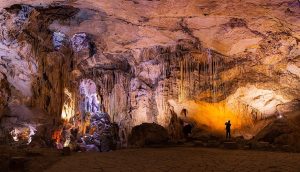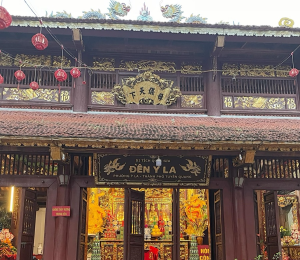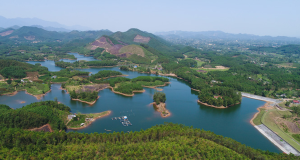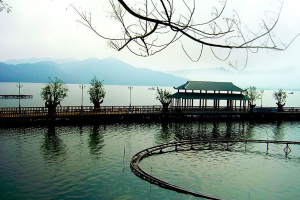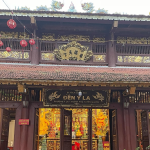Explore Hanoi’s grand Vietnam-Soviet Friendship Palace of Culture and Labour. Discover its history, architecture, events, and how to plan your visit!
Introduction to the Vietnam-Soviet Friendship Palace of Culture and Labour

The address is 91 Tran Hung Dao Street, Hoan Kiem District, Hanoi, Vietnam. Vietnam-Soviet Friendship Cultural Palace is a very outstanding architectural and cultural treasury of the country. This large building hosts artistic performance events, scientific conferences, and exhibitions. The construction of the palace began on January 1st, 1978, at the site of the previous Hanoi Arena, which had been destroyed during the Second World War. It was completed on September 1, 1985, and the palace opened its doors to the public.
Historical Background of the Vietnam-Soviet Friendship Palace

The Vietnam-Soviet Friendship Palace of Culture and Labour manifests the close relations between Vietnam and the former Soviet Union. Construction began on January 1, 1978, at the old site of the Hanoi Arena, which was destroyed during World War II. It was designed by the Soviet architect Garol Grigorevich Isakovich as a gift from the Soviet Union’s Central Trade Union Council to the Vietnamese Trade Union. The palace was officially inaugurated on September 1, 1985.
Over the years, the palace has been a frontline venue for various events, including the 2006 APEC Summit and the 1000th anniversary celebrations of Thang Long, Hanoi. The palace has received numerous honors, such as the Order of Labor, Third Class.
In recent years, the palace has gone through some changes. In 2019, the International Press Center for the US-North Korea Summit was hosted here. In September 2019, however, a fire seriously damaged it. Not to be daunted by such a mishap, renovations by the officials began, hoping to bring it back to its glory. In 2021, the modernized and expanded plans were in the operations of the palace.
Located in Hanoi, the Vietnam-Soviet Friendship Cultural Palace stands out as one of the cultural icons with a rich history and diversified programming while remaining under renovation to ensure its continued relevance and importance to the city.
Architectural design and features of the palace

The main building of the Vietnam-Soviet Friendship Palace of Culture and Labour stands as a breathtaking combination of architectural splendor and functional design. Situated on a broad 3.2-hectare site, the entire complex was dominated by a four-story main building measuring 96 meters in length, 60 meters in width, and 33 meters in height. This towering structure is complemented by a parallel three-story building adjoined to the principal one through a flat-roofed building with a terrace.
Built for such multi-functionality, the palace contains several rooms of various sizes to host more than one activity at a time without any disturbance. The most spacious is a huge auditorium which is fully equipped with state-of-the-art technology and a huge revolving stage to hold mega performances and can hold over 1,100 people. Under this stage, a complex system of cables, electric panels, and lamps exists.
Of the special features of the palace, perhaps one of the most unique touches is its pervasive use of specialized lighting. As a matter of fact, the former deputy director has said that these lights installed in the corridors were for the mines, brought over by Soviet engineers. Indeed, such attention to detail and the introduction of pragmatic features blend a range of aesthetics and functionality into the palace.
The general design of the Vietnam-Soviet Friendship Cultural Palace follows the standard pattern of Soviet Socialist Realism, resorting to monumentality, symmetry, and classical forms. Its huge scale and decoration create striking visual effects, making it one of the distinctive features of Hanoi.
Cultural and social events hosted at the palace
The Vietnam-Soviet Friendship Palace is one place where all forms of cultural events have been vividly executed and have shaped the face of Hanoi one way or another. Many world-renowned artists have taken center stage here to showcase their craft.
A stage for renowned artists
The palace has been a premier venue for countless performances by celebrated Vietnamese artists. From iconic singers like Mỹ Linh, Mỹ Tâm, and Hồng Nhung to the trio Trọng Tấn, Đăng Dương, and Việt Hoàn, some of the country’s most memorable live shows have taken place at this palace too.
Significant Events’ Hub
Due to its size and centrality, the palace has hosted some very high-profile events nationally and internationally. Its many state guests have included Putin, Medvedev, Trump, Kim Jong Un, the APEC Summit, and the US-North Korea Summit.
A Community Center
Aside from such events, the palace has also served as a civic center, offering classes and activities of all types to individuals of all age groups. The palace has offered dance and music lessons, art classes, and exercise programs where hundreds of people have pursued their interests and found new friends. At the same time, it has acted as a home for cultural clubs or community events. Other amenities include a sauna, tanning beds, and exercise equipment.
A Popular Landmark
The Vietnam-Soviet Friendship Palace of Culture and Labour has become one of the favorite sights in Hanoi, which many generations of Vietnamese people love. The impressive building, full of history and multifunctionality, is representative of a place that locals and tourists alike would continue to seek out.

The role of the Palace in Vietnam-Soviet Relations
The Vietnam-Soviet Friendship Cultural Palace is more than just a building, it has been a living embodiment of continued friendship between the two nations, Vietnam and the former Soviet Union. Besides its architectural significance, the palace has contributed much to the fostering of cultural exchange, developed social activities, and supported Vietnamese society in its development.
Thus, the palace, initially intended as a symbol of close friendship and brotherly relations between these two states, was bit by bit turning into a multi-functional cultural center. All these years, it has been a place of various political events, having hosted numerous gatherings of the Vietnamese Communist Party and the government of this country. Besides that, the Palace has actively participated in the cultural life of Hanoi, providing both financial and professional support to local communities in the organization of cultural and sports events. It has also extended its influence beyond the capital, as the palace has been very instrumental in training cultural cadres and in facilitating cultural exchanges throughout Vietnam.
Throughout the years, the Vietnam-Soviet Friendship Cultural Palace has deeply entrenched itself in the collective memory of Vietnamese people, especially Hanoi’s inhabitants. It has earned a special place in the hearts of many who refer to it simply as “Cung Việt Xô” or “Cung Công nhân” in Vietnamese, which means Vietnamese-Soviet Palace or Workers’ Palace. The enduring popularity is in itself a testimony of the palace’s significance as a cultural icon and a symbol of the enduring friendship between Vietnam and the former Soviet Union.

Read more: Hanoi Must Dos: Best things to do in Hanoi Old Quarter
How to get to the palace, best visiting hours
The Vietnam-Soviet Friendship Palace of Culture and Labour is conveniently located in the heart of the Hoan Kiem district at 91 Tran Hung Dao Street in Hanoi. It is one of the busy areas with developed transportation means to facilitate commuting.
The palace is open every day from 8:00 AM until 10:00 PM. Such an extended schedule enables the visitors to see all the exhibits, attend performances, or simply take a rest in the peaceful surroundings.
Getting There
- Public transportation from the palace is facilitated by several bus routes, including 32, 49, 86, and CNG 03, each day. This makes it very easy to get to the palace in a moderately priced way from any other part of the city.
- Private Transportation: You can also use taxis, ride-sharing services, or your own vehicles. The palace grounds have sufficient parking areas for visitors who come by car.

Read more: Fueling Your Hanoi Adventures: Best Breakfast in Hanoi Old Quarter
Nearby cultural and historical landmarks to visit
It is highly recommended to combine visiting the Vietnam-Soviet Friendship Cultural Palace with an excursion through other sightseeing places that are cultural and historical in Hanoi. Some suggestions follow:
- Hoan Kiem Lake: A serene lake right in the center of Hanoi, surrounded by charming cafes and historical sites.
- Ngoc Son Temple: Situated on a small island in the center of Hoan Kiem Lake, it is beautiful.
- Hanoi’s Old Quarter blends a labyrinthine area full of traditional crafts and succulent street food.
- Ho Chi Minh Mausoleum: This complex is home to the embalmed body of Ho Chi Minh, the nation’s hero.
- Vietnam National Museum of History: This museum houses an enormous collection of artifacts and exhibits depicting the rich history of Vietnam.

The Vietnam-Soviet Friendship Palace of Culture and Labour is a standing testament to the close friendship between Vietnam and the former Soviet Union. This architectural masterpiece has played many roles, serving as a cultural home, a core event center, and a community focal point for generations of inhabitants in Hanoi. From the impressive scale and complicated design to the different types of programming, everything tends to inspire its guests continuously. Whether you are interested in history, culture, or a special experience, the Vietnam-Soviet Friendship Cultural Palace takes care of the interests of all visitors.
Hanoi has many attractions that make you feel overwhelmed when planning a visit. Don’t worry, Lily’s Travel is here to address the problem for you. Established in 2007, Lily’s Travel has quickly become a leading tour operator in Vietnam, renowned for its exceptional service and commitment to sustainable tourism. With a focus on cultural immersion and community engagement, Lily’s Travel offers a wide range of tours that showcase the beauty and diversity of Vietnam, Laos, and Cambodia.





